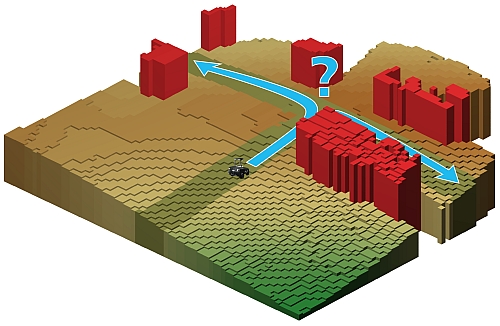Brief description of the project
SAM-UGV: Semi-Autonomous Unmanned Ground Vehicle System Demonstrator
Multisensorially equipped mobile autonomous robot systems can make a decisive contribution to the monitoring of endangered public and industrial properties. More efficient and reliable than security guards, they are able to patrol largely autonomously, automatically recognize suspicious situations and carry out appropriate alarm measures.
To evaluate the future performance of such systems, the European Defence Agency (EDA) has initiated the SAM-UGV project, which aims to create a demonstrator in the form of a semi-autonomous mobile platform. This platform should be able to explore unknown properties and autonomously perform guard duties.
Project description
Path planning operates in the field of tension between two opposing worlds: The data on which path planning operates are of a discrete nature, since for reasons of efficiency it is not possible to model the environment in any level of detail. It is therefore represented in the form of a "cell map" in which each cell has information about the height and nature of the terrain. On the other hand, the movement of the platform is of a continuous nature, so that the kinematic boundary conditions of the mobile platform must be taken into account during path planning.
Starting from the current vehicle position, a prediction of the vehicle motion is performed using a small path increment along different motion primitives. Subsequently, each new space-continuous vehicle position is evaluated by calculating the "costs" incurred during the path increment. In addition, a heuristic is used to estimate how favorable the new position is with respect to the next target. From these two quantities it can then be determined which movement primitive is to be followed up as the next one. These steps are performed iteratively until the given goal is finally reached.
.
In addition to the basic path planning functionality, the developed path planning concept has a number of additional functionalities, which enable robust path planning, especially in completely unknown areas. For example, the vehicle is able to independently explore a large unknown obstacle. For this purpose, local environmental scans are fused with the terrain data of the cell map and characteristic geometric structures, such as walls or ramparts, are extracted. By following these structures, the mobile platform is able to complete its knowledge of the environment and thus to find a way to the next destination.
Project goals
In addition to the hardware-technical structure of the platform, the development of suitable algorithms and software modules to enable the autonomy of the mobile platform represents a special challenge. Within the scope of the SAM-UGV project, Diehl BGT Defence is responsible for the development and implementation of comprehensive autonomy functionalities.
Due to the specific application scenario, special requirements are placed on the path planning algorithms: The path planning must generate a path in unstructured terrain - also beyond roads - which meets certain boundary conditions. These include, for example, the explicit consideration of vehicle kinematics constraints (restricted steering angle, non-holonomic behavior, maximum gradeability). In addition, the path planning should be parameterizable with regard to cost optimization. This includes factors such as the shortest possible path or the highest possible energy efficiency. Furthermore, the mobile platform must be able to safely avoid static obstacles and to avoid dynamic obstacles such as those presented by other road users.
Project results
To support our customers from the idea to the practical implementation, the IOSB creates software modules within the SAM-UGV project, which contain the developed algorithms to solve the presented tasks. Thanks to defined interfaces, these modules can be integrated directly into the framework of the target platform and thus easily extend its functionality. In order to be applicable in reality, the developed algorithms guarantee an execution with the agreed update rate. example;
 Fraunhofer Institute of Optronics, System Technologies and Image Exploitation IOSB
Fraunhofer Institute of Optronics, System Technologies and Image Exploitation IOSB 